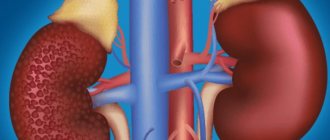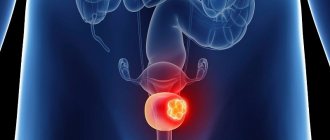Pyelonephritis is an inflammation of the kidneys that has a bacterial basis.
Pyelonephritis can be primary or secondary (obstructive). Obstructive occurs due to other disorders of the urinary system, disturbances in the outflow of urine, so it is important to promptly treat urolithiasis so that the stones do not interfere with the physiological outflow of urine and do not damage the kidneys. Symptoms of pyelonephritis may also differ between acute and chronic forms of the disease.
Symptoms of acute pyelonephritis
The acute form of kidney inflammation manifests itself with striking symptoms:
- chills, loss of strength, general malaise, heavy sweating;
- the temperature can rise to 39-40 ° C;
- headaches, especially in the frontal part;
- nausea and vomiting are a consequence of general intoxication;
- muscle and joint pain scattered throughout the body;
- Sometimes changes occur in the gastrointestinal tract - diarrhea.
With obstructive pyelonephritis, it often begins with renal colic. Acute pain is followed by a rapid rise in temperature and deterioration in general condition. The person begins to sweat profusely, the temperature drops sharply, and a period of imaginary well-being begins. But if the cause of the obstruction of urine outflow is not eliminated, then over time more serious symptoms will appear, especially if we are talking about a purulent form:
- increased pain in the lumbar region;
- muscle tension in the lower back and anterior abdominal wall;
- the affected kidney enlarges, it is clearly felt upon palpation;
- dehydration;
- the patient’s facial features become sharper and their appearance changes;
- sometimes euphoria sets in.
Factors contributing to the development of inflammation:
- The presence of diseases of the genitourinary system (cystitis, urethritis, urolithiasis).
- Poor circulation (due to plaque deposition in blood vessels, vasculitis, diabetic angiopathy, hypothermia, etc.).
- Impaired urine outflow (with ureteral reflux, adenoma, stones, etc.).
- Contamination of the genital organs as a result of poor personal hygiene, wearing a catheter, or urinary and fecal incontinence.
You can also get pyelonephritis if your general and local immunity is weakened, if you have severe chronic diseases (diabetes mellitus, AIDS, systemic diseases), or if you use certain medications, for example, glucocorticosteroids.
Symptoms of pyelonephritis in men and women
The structural features of the urinary system affect the course of pyelonephritis. Since women have a shorter urethra, it is easier for infection to reach the kidneys; pyelonephritis is often a consequence of untreated cystitis. Women more often suffer from kidney inflammation; the symptoms of pyelonephritis are more pronounced in them:
- rise in body temperature above 38 °C;
- characteristic features of general intoxication;
- change in the color of urine - up to a dirty yellow or darker color, and in case of urolithiasis and renal colic, there may be blood impurities in it.
Symptoms of pyelonephritis in men are often more subtle:
- thirst and dry mouth;
- general malaise;
- pain in the lumbar region.
Symptoms of kidney disease
The initial stage of the disease has an asymptomatic course. Most manifestations of pathologies are unspecific. These disease symptoms include:
- weakness;
- dizziness;
- feeling of chronic fatigue.
These manifestations are associated with changes in hormonal levels. Due to impaired renal function, the synthesis of erythropoietin decreases. Normally, it is produced in the kidneys and is involved in the synthesis of red blood cells. Due to a decrease in the amount of hormones in the blood, the synthesis of red blood cells is disrupted, as a result of which the body cells suffer from a lack of oxygen.
The main symptoms of kidney disease:
- Painful sensations. Localized in the lumbar region. The nature of the pain can be: dull, aching, paroxysmal, acute. The pain may radiate to the abdomen and groin area.
- Urinary disorders. There is increased urine output, especially at night. Pain may also occur during urination.
- Increased body temperature, chills.
- Edema. The most common location of renal edema is the face and legs.
- Increased blood pressure (secondary arterial hypertension).
- Metallic taste in the mouth.
- Bad breath (most often ammonia).
- Symptoms of body intoxication (nausea, vomiting).
- Changes in urine laboratory tests.
Who gets sick more often: men or women?
Women are most susceptible to kidney and urinary tract diseases. The most common pathologies among them are:
- urethritis – inflammatory disease of the urethra;
- cystitis is an inflammatory disease of the bladder;
- pyelonephritis – inflammatory kidney disease;
- urolithiasis is a pathology accompanied by the formation of stones in the bladder and kidneys.
Kidney diseases are also widespread among men. However, due to their asymptomatic course, they often detect pathologies in later stages. Tests will show specific changes.
Symptoms of kidney disease in pregnant women
During pregnancy, kidney pathologies are most often characterized by:
- severe chills;
- severe headaches;
- feeling of aching in muscles and joints;
- increased heart rate, shortness of breath;
- increased sweating;
- lethargy, adynamia;
- pain on the affected side;
- possible increase in discomfort at night, when walking, climbing stairs, etc.
For diagnosis, ultrasound examination, clinical blood test, and general urine test are prescribed. It is important to carry out timely treatment of renal pathology during pregnancy. Since the lack of adequate therapy can lead to acute gestational inflammation of the kidneys, as well as miscarriage.
Common kidney diseases
The most common kidney diseases are:
- pyelonephritis (acute and chronic);
- glomerulonephritis (acute and chronic);
- kidney cysts;
- urolithiasis disease.
Pyelonephritis
It is an inflammatory disease of the kidney parenchyma and pyelocaliceal system. Pathology of the urinary system is caused by:
- E. coli (about 80% of cases);
- staphylococcus (up to 20% of cases).
Quite often, pyelonephritis develops due to lack of treatment for colds. According to statistics, no more than 50% of patients go to hospitals for the treatment of acute respiratory viral infections and acute respiratory infections.
In women, pyelonephritis is more common: it occurs 6 times more often than in men. Pyelonephritis can be a complication of such important diseases as diabetes mellitus and urolithiasis.
Acute pyelonephritis, if left untreated or inadequately treated, can become chronic. To diagnose pathology, the following is carried out:
- Ultrasound of tissues and organs;
- clinical blood test;
- blood chemistry;
- general urine analysis.
Pyelonephritis is rarely fatal. However, its main danger is repeated relapses and the risk of developing sepsis. Over the past 20 years, the number of pregnant women suffering from kidney disease has increased 5 times.
Pyelonephritis is diagnosed not only in adults, but also in children under 7 years of age. Therefore, it is important to contact your pediatrician if symptoms of colds and inflammatory diseases occur.
Urolithiasis disease
Most often, the disease is a consequence of metabolic disorders in the body. With an increase in urine concentration, the process of stone formation is activated. The most common stones are formed from uric acid, oxalates and calcium.
Urolithiasis is quite often a hereditary pathology. Therefore, if stone formation has been observed in close relatives, it is advisable to regularly conduct preventive examinations and laboratory tests.
Also, a tendency to the appearance of stones can occur in people:
- obese;
- consuming large amounts of salty foods;
- living in hot climates;
- drinking insufficient amounts of water.
Men are more likely to suffer from urolithiasis. The most common manifestation of ICD is renal colic. This condition is accompanied by severe pain. It occurs in the lumbar region and can be localized on both the left and right sides. Renal colic occurs when a stone passes through the ureter and continues until the formation enters the bladder.
Nephroptosis
Pathology that is accompanied by prolapse of one or both kidneys. The disease can be asymptomatic for a long time, and pain appears mainly during physical activity. Most often, the first signs of pathology appear at the age of 20–40 years. The right kidney is more susceptible to prolapse due to weakness of the ligamentous apparatus.
Nephroptosis can result from:
- pregnancy and childbirth;
- playing sports (weightlifting);
- high level of physical activity during work;
- sudden weight loss (most often observed in girls during adolescence).
The organ can not only descend, but also deviate horizontally and twist around its vascular pedicle. As a result, renal blood flow is impaired and pressure inside the organ increases.
Nephroptosis, as a rule, does not affect well-being. However, symptoms may occur when the ureter is kinked, urine stagnation and stone formation.
Nephroptosis can cause spontaneous abortions in the early stages. And high blood pressure can cause heart attacks and strokes.
Kidney cysts
They are usually an incidental finding during ultrasound diagnostics. The asymptomatic development of cysts is especially common in men. At its core, a cyst is a round-shaped formation that has a thin capsule and is filled with fluid.
They can be either simple or multiple, congenital or acquired. The most common are simple cysts.
A cyst of the left kidney and the right is a designation for a whole group of diseases. They include, polycystic kidney, multicystic, spongy kidney, multilocular cyst, etc.
An acquired kidney cyst can be a consequence of many diseases:
- chronic pyelonephritis;
- urolithiasis disease;
- parasitic infestations (echinococcosis);
- frequent hypothermia;
- traumatic injuries.
Diagnosis of renal cysts is extremely important, since some types have an increased risk of malignancy. Early detection of pathology is difficult due to its asymptomatic course. The first signs of the disease appear due to the increase in size of the cyst.
Suspicion of a cyst usually arises after the appearance of complaints and complications. The symptoms of kidney cysts are similar to other kidney diseases, so ultrasound diagnostics with Doppler sonography plays an important diagnostic role.
Additionally can be used:
- excretory urography;
- CT scan;
- multislice computed tomography.
Glomerulonephritis
This pathology is of autoimmune origin. Most often, both kidneys are affected, and the course of the disease steadily progresses. Inflammation is immune in nature. The body's protective cells damage the glomeruli (glomeruli).
The course of glomerulonephritis can be acute or chronic. Acute pathology most often occurs in children of the younger age group. The chronic course of the disease is diagnosed more often. The gradual progression of pathology is one of the common causes of the development of chronic renal failure (CRF). Glomerulonephritis affects men more often. Women are less susceptible to the development of pathology: glomerulonephritis occurs 2–3 times less often in them.
The development of the disease may be associated with a primary autoimmune process, for example, systemic lupus erythematosus, autoimmune vasculitis, etc. However, more often glomerulonephritis is a consequence of an infectious disease of bacterial or viral etiology.
Another reason for the development of glomerulonephritis may be intoxication. Poisoning of the body may be associated with taking certain groups of nephrotoxic drugs, low-quality alcohol (or a large amount of it).
Risk factors for developing glomerulonephritis:
- lumbar region injuries;
- occupational hazards;
- severe hypothermia;
- oncological diseases, etc.
Typical symptoms of glomerulonephritis:
- morning swelling of the face (may persist throughout the day);
- persistent arterial hypertension (secondary);
- oliguria (decreased daily urine volume);
- macrohematuria (red urine, “meat slop”);
- microhematuria (the presence of red blood cells in the blood without staining the urine).
The color of urine with glomerulonephritis can vary from pink and brown-red to black. The pathology is also accompanied by other symptoms characteristic of renal pathology:
- headache;
- weakness;
- increased fatigue, etc.
If you start treatment of acute glomerulonephritis in a timely manner, you can completely get rid of the pathology in 2-3 months. A sluggish process or untimely, inadequate treatment can cause the transition of acute kidney inflammation to chronic.
Complications of glomerulonephritis may include:
- acute renal failure;
- acute heart failure;
- hemorrhagic stroke;
- uremia (saturation of blood with nitrogenous compounds, creatinine, urea).
Uremia can even cause death due to inhibition of the functions of the central nervous system and the development of uremic coma.
Diagnosis of glomerulonephritis is based on laboratory diagnostic data (clinical blood test and general urine test). Instrumental examination methods intended for the diagnosis of glomerulonephritis are:
- Ultrasound of the kidneys with Doppler examination;
- biopsy followed by histological examination.
Kidney pathology: diet therapy
A mandatory stage of kidney treatment is the appointment of an adequate diet. Basic nutritional recommendations:
- small and frequent meals;
- drinking 1.5 liters of fluid per day;
- refusal of alcoholic drinks of any concentration.
The following foods should be excluded from the diet:
- fatty meat broths;
- legumes;
- fat meat;
- salt, herbs, spices;
- chocolate.
Most often, in case of kidney pathology, diet No. 7 is prescribed, while the body should receive less salt and proteins.
Conservative treatment for renal pathologies
Comprehensive treatment of kidney diseases allows you to get rid of the disease forever. Therapy must be prescribed by a doctor after a preliminary examination. Self-medication for kidney pathologies can be dangerous to health and life.
Surgical treatment of kidney diseases
If there is no effect from conservative therapy, a decision is made on surgical treatment. The most commonly used:
- Nephrostomy. The procedure is aimed at normalizing the outflow of urine by removing the stoma. This can relieve pain due to high blood pressure and avoid worsening kidney infections.
- Stenting. During the operation, stents are installed to normalize the patency of the urinary tract.
- Nephrotomy. Removal of a kidney or part of it.
- Transplantation (kidney transplant). It is used when chronic renal failure increases and the effectiveness of hemodialysis decreases. Most often, this need arises in chronic glomerulonephritis.
Results-oriented prevention of kidney disease
To reduce the risk of developing kidney disease, you should first think about prevention and lifestyle correction. The main recommendations are:
- moderate regular physical activity;
- balanced diet with sufficient vitamins and minerals;
- Drinking enough fluids daily. The norm is calculated individually based on the level of physical activity and body weight.
Avoiding bad habits will help keep your kidneys healthy: smoking, alcohol, using narcotic and psychotropic substances.
If infectious diseases occur, it is necessary to promptly contact a specialist to prevent the transition of an acute process to a chronic one.
Symptoms of chronic pyelonephritis
The chronic course is characterized by alternating acute phases and stages of remission. The active period will be characterized by the symptoms of acute pyelonephritis described above. And in the remission stage, a person may feel the following symptoms of chronic pyelonephritis:
- dull pain in the lower back;
- fatigue and lethargy;
- temperature rise to subfebrile levels;
- loss of appetite, nausea.
Without treatment, chronic renal failure occurs; a secondary wrinkled kidney becomes an ultrasound sign of chronic pyelonephritis. Another symptom of late-stage disease is high blood pressure.
Causes of kidney diseases
Most renal pathologies are congenital and/or hereditary. They account for more than 70% of cases. External and internal factors provoke the appearance of diseases in only 30% of cases.
Factors contributing to the development of kidney disease are:
- past infectious diseases;
- regular consumption of hot, salty and spicy foods;
- hypothermia of the body;
- chronic infectious processes;
- poisoning and intoxication;
- alcohol abuse;
- diabetes;
- angiopathy of various origins;
- some somatic diseases of internal organs.
The most common congenital pathologies are:
- Aplasia. Underdevelopment of an organ due to intrauterine defects. As a result, one or even both kidneys cannot fully perform their functions.
- Agenesis. Congenital absence of one or both kidneys.
- Kidney doubling. A rather rare pathology that occurs in only 10% of cases. It can be complete or incomplete. With this malformation, the renal filtration function is preserved.
Diagnosis and treatment of kidney diseases are often difficult. This occurs due to the asymptomatic course of many pathologies. Patients complain only when the disease is advanced and disrupts the functioning of other organs and systems.
Some people unknowingly harm the body's main filter. For example, impaired renal function can be caused by taking certain groups of medications:
- analgesics;
- antibiotics;
- antiviral drugs;
- psychotropic drugs;
- antihypertensive drugs (lowering blood pressure) and some others.
Symptoms of pyelonephritis in pregnant women
During pregnancy, a woman's kidneys experience maximum stress. The growing uterus puts pressure on the urinary system, the sepal system and ureteral canals expand. All this leads to the fact that pregnant women have an increased risk of pyelonephritis. Symptoms of pyelonephritis in pregnant women are similar to those observed in the acute form of the disease:
- signs of intoxication;
- lower back pain;
- change in urine color;
- fever.
Diagnosis of the disease
Patients with symptoms of pyelonephritis usually consult a general practitioner, pediatrician, urologist or nephrologist. In most cases, it is not difficult for a doctor to diagnose a disease based on a conversation with the patient, anamnesis, and a general examination. To confirm the diagnosis, laboratory tests are prescribed:
- general blood analysis;
- blood chemistry;
- general urine analysis;
- bacterial culture of urine;
- Nechiporenko's test;
- Zimnitsky's test.
In a general blood test, changes characteristic of inflammatory processes are detected: leukocytosis and accelerated ESR; in a biochemical test, an increase in urea and creatinine levels is possible. In a general urine test, leukocytes and bacteria may appear; the urine is cloudy, may be reddish in color, and has an alkaline reaction. Based on the results of bacterial culture, the pathogen that caused the disease and its sensitivity to antibiotics are determined. Using the Zimnitsky test, the concentration function of the kidneys is assessed, Nechiporenko tests - the ratio of leukocytes and erythrocytes per unit volume of urine. Source: Diagnosis and treatment of acute pyelonephritis. Beshliev D.A., Khodyreva L.A. Difficult patient, 2007. p. 5-8.
To confirm the diagnosis and differential diagnosis of pyelonephritis from other diseases, assess the condition and function of the kidneys, the doctor may prescribe the following examinations:
- Ultrasound of the kidneys and other organs of the urinary system;
- CT scan;
- excretory urography.
Women are recommended to consult a gynecologist.
Treatment
Since acute pyelonephritis often becomes chronic, which can lead to morphological changes in the kidneys and disruption of the entire urinary system, you should consult a doctor at the first symptoms of pyelonephritis.
At the Clinic of Urology named after R. M. Fronshtein of the First Moscow State Medical University named after I.M. Sechenov (State Urology Center) will definitely help you. Do not self-medicate and do not waste precious time, remember that the kidneys are a vital organ. July 25, 2020
Hakobyan Gagik Nersesovich - urologist, oncologist, MD, doctor of the highest category, professor
All the symptoms of the disease...
Diagnosis of kidney infection (pyelonephritis)
How do healthcare providers diagnose a kidney infection?
Health care providers use your medical history, physical examination, and tests to diagnose a kidney infection.
The doctor will ask if you have a history of health conditions that make you more likely to develop a kidney infection. During your physical examination, your health care professional will ask you about your symptoms.
If you are a man and your doctor suspects you have a kidney infection, he or she may do a digital rectal examination (DRE). During a DRE, your healthcare provider asks you to lean over a table or lie on your side, keeping your knees close to your chest. Wearing a glove, the health care professional places a lubricated finger into the anus to check for a swollen prostate or an enlarged prostate blocking the bladder neck.
What tests do doctors use to diagnose a kidney infection?
Doctors may use laboratory or imaging tests to diagnose a kidney infection.
Laboratory tests
Analysis of urine . For a urine test, you will collect a urine sample in a special container at your doctor's office or laboratory. The healthcare professional will examine the sample under a microscope to look for bacteria and white blood cells, which the body produces to fight infection. The bacteria can also be found in the urine of healthy people, so a kidney infection is diagnosed based on symptoms and laboratory testing.
Urine culture . A healthcare professional may culture the urine to find out what bacteria is causing the infection. A healthcare professional can see how the bacteria multiply, usually within 1 to 3 days, and then determine the best treatment.
Diagnostic tests
A healthcare professional may use diagnostic tests such as computed tomography (CT), magnetic resonance imaging (ultrasound), or ultrasound to help diagnose a kidney infection. A technician performs these tests at the NT-Medicine clinic. A technician can perform an ultrasound in a doctor's office. The radiologist reads and reports the images. You do not need anesthesia for these tests. Find out more about urinary tract imaging tests.
Why do kidney stones appear?
Kidney stones are mineral-salt deposits caused by a failure in metabolic processes. They are formed when urine becomes concentrated and its constituent substances—calcium, oxalate and uric acid—crystallize.
Oxalate is an enzyme produced by the liver and also found in fruits, vegetables and chocolate. With metabolic disorders or poor diet, the amount of oxalate in the urine increases, creating the preconditions for stone formation.
Struvite stones form when an infection enters the urine. Urate stones occur when there is an increased concentration of uric acid. The prerequisites for their formation are dehydration, excess protein foods and gout. When there is an excess of the amino acid cystine, cystine stones are formed.
Basically, stone formation is of a hereditary-genetic nature. People living in countries with hot climates are more prone to stone formation, because dehydration contributes to the formation of stones. Also at risk are people with excess body weight and lovers of salty foods. According to statistics, men are more susceptible to stone formation. Among them, 13% of the male population aged 30-60 years are affected by the disease, while women are 2 times less.
Removing kidney stones is much more difficult than avoiding the crystallization process. A thorough diagnosis in the clinic will identify the disease at the initial stage and prevent further stone formation.
Nephroptosis or why the kidney drops
Kidney prolapse occurs in 1.5% of women and 0.3% of men in the age group of 20-40 years. Prolapse of the right kidney is more often observed, because the left one is initially located higher than the right one and has a stronger ligamentous apparatus.
The organ changes its position not only vertically, but also deviates to the side or twists around its stem. This disrupts the position of blood vessels, impairs blood flow, and increases intrarenal pressure. Nephroptosis also provokes the development of pyelonephritis, because the incorrect position of the kidney contributes to stagnation of urine and the proliferation of pathogenic bacteria.
In itself, the prolapse of the organ does not affect health in any way, but a bend in the ureter with an incorrect position of the kidney provokes stagnation of urine and the formation of stones. Nephroptosis itself causes increased blood pressure, many times increasing the risk of heart attack or stroke. Kidney prolapse also provokes spontaneous abortion in pregnant women.
Causes of kidney prolapse
The following factors contribute to the development of nephroptosis:
- Pregnancy and childbirth . In unathletic women with poor physical fitness, the fixing apparatus of the kidney weakens during pregnancy and natural childbirth. In addition, the abdominal muscles also stretch, and the kidney loses support. Prolapse is facilitated by sudden weight gain and then weight loss. In general, all pregnant women, as well as mothers who have recently given birth to a baby, should especially closely monitor the health of their kidneys, because in the fair half of humanity, kidney disease worsens in the first year after childbirth.
- Weightlifting , lifting heavy objects. Fascia, sheets that attach the kidney to the peritoneum, pass into the diaphragm. They bear the main burden of keeping the kidney in the correct position.
- Overexertion caused by heavy lifting causes stretching of the ligaments holding the kidney, and it gradually drops. Nephroptosis is typical for weightlifters, construction workers, loaders, and some professional athletes. A serious consequence of the disease is arterial hypertension, which cannot be treated with conventional drugs.
- Sharp weight loss . This problem often arises among teenage girls who have complexes about their appearance and go on strict diets. Metabolism at a young age is good, so the results of the diet are noticeable.
If an adult, due to age-related metabolic characteristics, cannot quickly lose weight, then teenagers are able to lose up to 10 kg per month, which will have the worst impact on the condition of the kidneys.
The organ is located in a fatty capsule, which protects from cold and mechanical injury, and also allows the kidney to be fixed in a certain position. With a sharp decrease in weight, the fat layer becomes thinner, which causes sprains and prolapse of the organ. It is not advisable to lose more than 3 kg per month, otherwise it will affect not only your general well-being, but also the condition of your internal organs.
Nephroptosis is diagnosed at the earliest stages, when health has not yet suffered much damage. Clinical examination of the kidneys is the most effective method of preventing renal pathologies.









